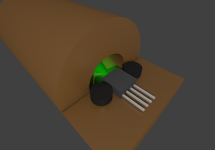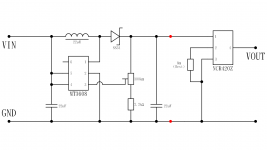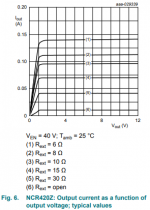Looking at Sharp's catalog, I noticed that other than the usual TO-can diodes they also offer some oddball diodes packaged in so-called "t1.8mm frame". Turns out these are Multiple Quantum Well diodes that don't sell for much (not much power either). I'm kind of surprised nobody mentioned them at all on LPF.

(Picture by LCSC)
They come in 3 flavors: 515nm 35mW, 638nm 100mW, and 660nm 100mW. I'm interested in the green one due to its wavelength.
According to the datasheet, the diode has a nominal wavelength of 515nm (range is 510-525nm). It runs on, wait for it... 7 to 8.5 volts at 90 to 135 mA. A quick search on quantum well diodes told me that they are supposed to be more efficient than normal diodes but calculating energy input with P=V*I says the opposite. A normal 520nm 35mW diode by Sharp runs 6.5 volts at 70mA.
Okay, so in order to use these diodes in a build there are 2 main issues, which are mounting and driver design.
(Before we get into it, it's worth mentioning that these diodes are tiny, the lead spacing is just 1mm apart).
1. Mounting


I think the simplest way to mount this diode is to use a proprietary optical shelf, which is raised at just the right height and uses 2 screws to hold the diode down. The diode can be lowered by sanding the shelf and raised by adding shims. Horizontal adjustment can be done manually before clamping down with screws.
2. Driver design.

I'm not sure if there's a better way to do this but I'm thinking about boosting the voltage to around 10 volts by using MT3608 driver, then bucking with NCR420U or NCR420Z to set the current at ~135mA. Red dots emphasize where the MT3608 module ends.
MT3608 chip is used in very cheap boost drivers, but I want to fit this in a very small build so I may need to replace the trimpot and inductor with smaller alternatives.

NCR420U/Z is a 150mA LED driver with a resistor (Rext) to set the current. 6 ohms will have it at around 135-140mA.
I'm sure there are lots of experts on this, so any advice on this driver design will be really appreciated
Anyways, thanks for reading. I really want to make a quirky little build out of this quirky little diode.

(Picture by LCSC)
They come in 3 flavors: 515nm 35mW, 638nm 100mW, and 660nm 100mW. I'm interested in the green one due to its wavelength.
According to the datasheet, the diode has a nominal wavelength of 515nm (range is 510-525nm). It runs on, wait for it... 7 to 8.5 volts at 90 to 135 mA. A quick search on quantum well diodes told me that they are supposed to be more efficient than normal diodes but calculating energy input with P=V*I says the opposite. A normal 520nm 35mW diode by Sharp runs 6.5 volts at 70mA.
Okay, so in order to use these diodes in a build there are 2 main issues, which are mounting and driver design.
(Before we get into it, it's worth mentioning that these diodes are tiny, the lead spacing is just 1mm apart).
1. Mounting


I think the simplest way to mount this diode is to use a proprietary optical shelf, which is raised at just the right height and uses 2 screws to hold the diode down. The diode can be lowered by sanding the shelf and raised by adding shims. Horizontal adjustment can be done manually before clamping down with screws.
2. Driver design.

I'm not sure if there's a better way to do this but I'm thinking about boosting the voltage to around 10 volts by using MT3608 driver, then bucking with NCR420U or NCR420Z to set the current at ~135mA. Red dots emphasize where the MT3608 module ends.
MT3608 chip is used in very cheap boost drivers, but I want to fit this in a very small build so I may need to replace the trimpot and inductor with smaller alternatives.

NCR420U/Z is a 150mA LED driver with a resistor (Rext) to set the current. 6 ohms will have it at around 135-140mA.
I'm sure there are lots of experts on this, so any advice on this driver design will be really appreciated
Anyways, thanks for reading. I really want to make a quirky little build out of this quirky little diode.
Last edited:




